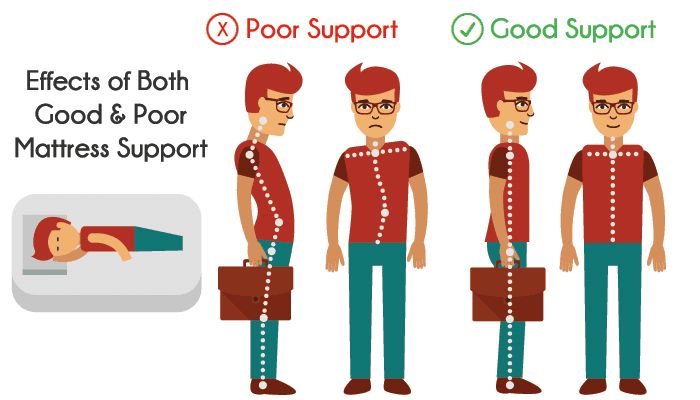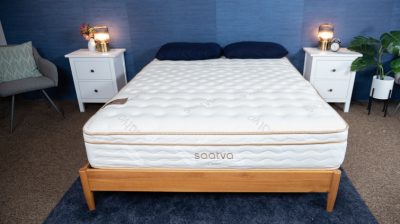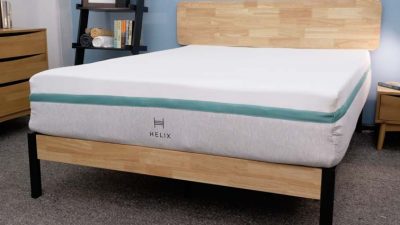A good mattress is the foundation of a good night’s sleep, so choosing which one is right for you really is a big decision. You spend a third of your life on it, and unsatisfactory sleep affects the rest of your life, too. Getting good quality, restful sleep is essential to general health and wellbeing.
The variety of mattress options on the market is enormous, making the final decision trickier than ever. And one of the biggest decisions in terms of mattress buying is the choice between purchasing a firm vs soft mattress. There are pros and cons for either, and really the choice is extremely personal. Here are some tips to help with your decision.

What Makes A Suitable Mattress?
Aside from personal preference, a main factor when choosing a suitable mattress is your spine health. The spine naturally has three slight curves, and they need to be supported even when you’re horizontal.
A good mattress will hold your body in a neutral position. This means your spine will be held in its natural slight curve, and your head, shoulders, buttocks and heels are aligned. On a perfect mattress, you should feel no pressure at all, almost as if you’re floating. Over time, the right mattress can relax muscles, encourage better sleep, and even improve posture. The wrong mattress could leave you waking up with back pain, particularly around the base of your spine, and can interfere with healthy sleep more generally.
What’s The Difference Between Firm and Soft?
The obvious difference between a firm on soft mattress is the feel. A firm mattress is more rigid to the touch and has less give. A softer mattress will compress more easily when pressure is applied.

It’s important to note that mattress feel is not just split into two categories – it’s more of a spectrum. This means there’s lots of choice, which can be both a positive and a negative.
All types of mattress can be made from all materials. The firmness or softness of a mattress either depends on the spring tension or general tension of construction within the mattress. However, a mattress can also include an outer layer or some upholstery which affects the perceived firmness. A memory foam topper, for example, can give a superficial feeling of firmness but not actually have the properties of a truly firm mattress.
Both types of mattress exist in a variety of budgets. However, in order to get exactly what you want, it can be worth spending a little extra.
Advantages Of A Firm Mattress
For those not experiencing troublesome back pain, a firm mattress is will generally be more comfortable. When sleeping on a firmer surface, the bones absorb most of the pressure, meaning there is less stress on muscles, veins and arteries. Muscles are less strained, and circulation is improved.
A firm mattress also keeps your lower back from collapsing, which could allow for more oxygen intake while sleeping. Less sagging can mean the weight of the body is distributed evenly, which means no one part of the body is bearing the brunt of the pressure.

Firm mattresses are generally better for those who sleep on their back, because they provide a more stable and even surface. Stomach sleepers tend to fare better on a firmer mattress, too.
The Saatva’s coil-on-coil construction provides a classic innerspring feel. It's a good option for combo sleepers, who will want to feel free to switch positions and avoid feeling “stuck” in the mattress. It comes in three firmness levels, so you should be able to find one that suits your needs.
We recommend this mattress for the following sleeper types: Financing options are available for this mattress. We were skeptical of buying a mattress on line but it could not have gone any smoother. Anthony answered all of our questions during our many phone conversations. Delivery was prompt and went without a hitch. Best of all the mattress is so comfortable! I haven't had such a good night sleep in years. Highly recommend this.
The Saatva’s coil-on-coil construction provides a classic innerspring feel. It's a good option for combo sleepers, who will want to feel free to switch positions and avoid feeling “stuck” in the mattress. It comes in three firmness levels, so you should be able to find one that suits your needs.
We recommend this mattress for the following sleeper types: Financing options are available for this mattress. We were skeptical of buying a mattress on line but it could not have gone any smoother. Anthony answered all of our questions during our many phone conversations. Delivery was prompt and went without a hitch. Best of all the mattress is so comfortable! I haven't had such a good night sleep in years. Highly recommend this.
The Saatva’s coil-on-coil construction provides a classic innerspring feel. It's a good option for combo sleepers, who will want to feel free to switch positions and avoid feeling “stuck” in the mattress. It comes in three firmness levels, so you should be able to find one that suits your needs.
We recommend this mattress for the following sleeper types: Financing options are available for this mattress. We were skeptical of buying a mattress on line but it could not have gone any smoother. Anthony answered all of our questions during our many phone conversations. Delivery was prompt and went without a hitch. Best of all the mattress is so comfortable! I haven't had such a good night sleep in years. Highly recommend this.
Saatva Mattress

Material
Innerspring
Trial Period
365 nights
Shipping Method
Free white glove delivery
Firmness
Multiple firmness options
Warranty
Lifetime warranty
Price Range
$$$$$
Hot Sleepers
If you often overheat while you sleep, this mattress should help you stay cool.
Back Pain
This bed is perfect for anyone suffering from back pain.
Back Sleeping
Ideal for lightweight, average weight, and heavyweight back sleepers.
Stomach Sleeping
Ideal for lightweight and average weight stomach sleepers.
Financing Options
Saatva Mattress

Material
Innerspring
Warranty
Lifetime warranty
Firmness
Multiple firmness options
Shipping Method
Free white glove delivery
Trial Period
365 nights
Price Range
$$$$$
Hot Sleepers
If you often overheat while you sleep, this mattress should help you stay cool.
Back Pain
This bed is perfect for anyone suffering from back pain.
Back Sleeping
Ideal for lightweight, average weight, and heavyweight back sleepers.
Stomach Sleeping
Ideal for lightweight and average weight stomach sleepers.
Financing Options

Saatva Mattress
Material
Innerspring
Firmness
Multiple firmness options
Trial Period
365 nights
Warranty
Lifetime warranty
Shipping Method
Free white glove delivery
Price Range
$$$$$
Hot Sleepers
If you often overheat while you sleep, this mattress should help you stay cool.
Back Pain
This bed is perfect for anyone suffering from back pain.
Back Sleeping
Ideal for lightweight, average weight, and heavyweight back sleepers.
Stomach Sleeping
Ideal for lightweight and average weight stomach sleepers.
Financing Options
Drawbacks Of A Firm Mattress
On a superficial level, the switch from a softer to harder mattress can initially feel very uncomfortable. This usually becomes less noticeable with time.
For those with specific back problems such as arthritis and scoliosis, a firmer mattress can actually exacerbate pain. This is why it’s essential to research mattresses before making a purchase.
Advantages Of A Soft Mattress
A softer mattress is usually recommended for those who are experiencing back pain on a standard mattress, or those who have pre-existing back problems. They’re also recommended for lighter individuals as a harder mattress can end up not compressing for them at all.
Softer mattresses are generally better for those who sleep on their side, as they better cushion the shoulders and hips. On the side, a softer mattress better aligns the spine, too.
The Helix Sunset is the brand's softest model, which makes it a great option for side sleepers looking for a plush, contouring feel. Its memory foam layer adds some nice sinkage and pressure relief as well.
We recommend this mattress for the following sleeper types: Financing options are available for this mattress. The Helix Sunset is the brand's softest model, which makes it a great option for side sleepers looking for a plush, contouring feel. Its memory foam layer adds some nice sinkage and pressure relief as well.
We recommend this mattress for the following sleeper types: Financing options are available for this mattress. The Helix Sunset is the brand's softest model, which makes it a great option for side sleepers looking for a plush, contouring feel. Its memory foam layer adds some nice sinkage and pressure relief as well.
We recommend this mattress for the following sleeper types: Financing options are available for this mattress.Helix Sunset Mattress

Material
Hybrid
Trial Period
100 nights
Shipping Method
Free shipping
Firmness
Soft: 5.5/10
Warranty
10-year warranty
Price Range
$$$$$
Joint Pain
This bed is perfect for anyone suffering from joint pain.
Back Sleeping
Ideal for lightweight and average weight back sleepers.
Side Sleeping
Ideal for lightweight and average weight side sleepers.
Financing Options
Helix Sunset Mattress

Material
Hybrid
Warranty
10-year warranty
Firmness
Soft: 5.5/10
Shipping Method
Free shipping
Trial Period
100 nights
Price Range
$$$$$
Joint Pain
This bed is perfect for anyone suffering from joint pain.
Back Sleeping
Ideal for lightweight and average weight back sleepers.
Side Sleeping
Ideal for lightweight and average weight side sleepers.
Financing Options

Helix Sunset Mattress
Material
Hybrid
Firmness
Soft: 5.5/10
Trial Period
100 nights
Warranty
10-year warranty
Shipping Method
Free shipping
Price Range
$$$$$
Joint Pain
This bed is perfect for anyone suffering from joint pain.
Back Sleeping
Ideal for lightweight and average weight back sleepers.
Side Sleeping
Ideal for lightweight and average weight side sleepers.
Financing Options
Drawbacks Of A Soft Mattress
Though they can seem more comfortable and luxurious, a soft mattress can actually cause back problems for back and stomach sleepers, and those of a heavier weight.
Soft mattresses can also be problematic for bed sharers. The heavier partner may sink further in, making the sleep surface unbalanced. Finding a firmness that suits both parties can be tricky.
In some cases, soft mattresses may be less long lasting than firm. All types of mattress tend to become softer over time, so starting from an already soft baseline can lead mattresses to become unusable after a shorter amount of time, though there are still many models that have excellent durability, even with a softer feel.
How To Choose What’s Right For You
The two main choices to consider are whether you generally suffer from back pain or not, and which sleeping position you favor. Those without back pain and who sleep on their back or stomach will likely favor a firmer mattress. Side sleepers or those with back issues may prefer something softer – although it ultimately comes down to personal preference. If a mattress isn’t enough to ease the pain at night, consider looking into our list of mattress toppers that help alleviate back pain.
Another thing that should be considered is weight. A heavier person may find a firm mattress deceptively soft, while a lighter person may not get a huge amount of give even from a softer mattress. Generally an average to heavy build will be better suited to a firmer mattress.
Another important element which should not be overlooked is personal preference. Regardless of which is more specialized for your spine’s needs, if you find it uncomfortable, you’re unlikely to get a good night’s sleep on it. And that is the main purpose of a mattress, after all. That’s why I recommend taking a look at our picks for the most comfortable mattress to find the best mattress that fits your needs.
It’s important to remember that the choice is not exactly black and white. There is a spectrum of firmness within mattresses. Furthermore, one can compromise by having a firm mattress in terms of spring suspension, but adding a plush, soft topper.
Overall, it’s really important to properly test out a mattress in order to make an informed choice. Simply sitting down on it in stores unlikely to cut it.
Summary
- There are a lot of factors to take into consideration when buying the perfect mattress for you.
- The two main factors in your mattress decision should be back pain and your sleeping position of choice.
- It’s also useful to consider things like weight, whether you share the bed or not, and personal preference.
- There are not two types of mattress in the world, and properly testing different options is the best way to make a personal decision.
- Sleepopolis can also help – we have plenty of in depth reviews of both firm and soft mattresses for your consideration, to help you make an informed choice.
There is a spelling error in the first FAQ
Mary, I don’t have scoliosis, but I do have back issues. A chiropractor told me that I’m slightly uneven, meaning my right leg is a bit long than my left. It’s not noticeable unless your a person who knows about that kind of stuff but he said it starts in my back and can feel and see in x-ray where it’s all at. I went and saw him before we got our new mattress bc I was waking up with so much back pain that as time went on it was becoming unbearable and I would start crying everytime I woke up. He told that I should try staying away from soft things like a mattress and couches. Funny, bc I did notice that when sitting on my couch after a bit my back would start to hurt. When we went to sleepys to get a new mattress we took their soft/firm test and it said we would get a soft mattress, claiming it would be better for us. I’m a side sleeper mostly bit will wake up being on my back. We went with a firm mattress bc I told my husband with time it will get soft so if it’s too hard now we can get a topper but we didn’t need it bc getting a firm mattress was the best thing I ever did for myself. Now this mattress we got it 10 years old and I’ve been waking up sore again so we are looking into getting a new one. I wanted to double check things again before we purchase one again. Everything I read says I should get a soft mattress being a side sleeper and back pain but I don’t think it will be good for me. Not sure why everything says a soft mattress is good for back pain but my chiropractor told me the opposite which ended up being right. Weird
Your chiropractor is correct. It is actually firmer mattresses that are better for back pain. Ive just spent 3 days of resesrch in stores and readi g and the majority say if you have pain to go firm.. But light person under 150 lbs who is a side sleeper w pain may want a plush layer in pillow top on top of a firm mattress.
Aldo apparently most people dont understand what “soft” means in mattres language i sure didnt so i ordered a doft memory foam bcus pain tho i am tummy sleeper and heavy man. its 10″ and i sit on it the edge compresses to 1″! i sink in laying down. Im returning it and. buying a firm hybrid or a firm.innerspring with a plush pillowtop.
What i meant by thinking i want “comfy, soft” was really i wanted *responsiveness* ie bounce. Which is a quality of firm mattresses, not soft ones.
Also i love ztempur Pedic (i cant afford one) so thought that meant id live memory foam
Absolutely not. Tempur Pedic is NOT like memory foam. Its a unique material and it is more like a firm hybrid than like a sift memory foam. Who knew?
If one has pain or side sleeper ones probably best with hybrid or innerspring w pillowtop. the heavier you are the firmer and thicker– add girmer if not side sleeper. If over 230 lbs definitely 12+”.
It can be quite confusing and counter intuitive!
Great post! Thank you for sharing this amazing info, its very informative and useful for me.
I have moderate scoliosis. From both my experience and my reading, I have found that a firm mattress is usually better for people with scoliosis.
I have a dust mite/allergy cover that fully wraps around my entire mattress. I also place an extra cover that just goes over the top so I don’t have to unzip the entire dust mite cover and wash it, I just wash the extra top cover from time to time. I haven’t had any major allergies ever since I covered it.
This is such a great idea for allergy sufferers!
Do mattresses gather dust mites & be chg’d often? I am allergic to dust want to know people with allergies if mattress be cleaned with soap & damp cloth?
Martha, As per a research, the weight of any mattress doubles in 10 years this means that all the dead skin that we shed and other mites and bugs make up for the same weight as of the original mattress in about 10 years.
https://www.livescience.com/33097-does-your-mattress-really-gain-weight-over-time-.html
Cheers!
Very helpful